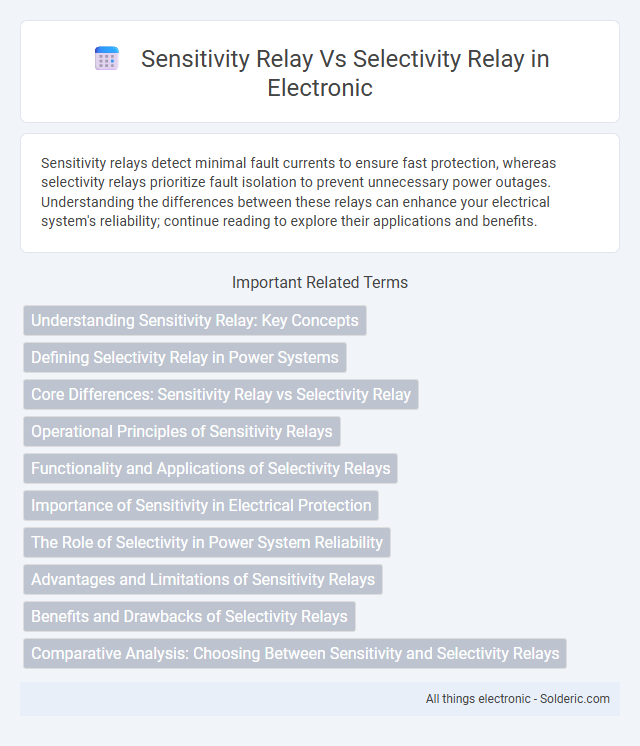Sensitivity relays detect minimal fault currents to ensure fast protection, whereas selectivity relays prioritize fault isolation to prevent unnecessary power outages. Understanding the differences between these relays can enhance your electrical system's reliability; continue reading to explore their applications and benefits.
Comparison Table
| Feature | Sensitivity Relay | Selectivity Relay |
|---|---|---|
| Primary Function | Detects low-level fault currents or signals | Discriminates between faults to isolate the correct section |
| Operation | Operates on minimal current variations | Operates based on fault location and priority |
| Application | Used for sensitive fault detection in protection systems | Used for coordination in protection schemes to avoid unnecessary trips |
| Response Time | Typically faster to detect minor faults | May have deliberate delays for proper selectivity |
| Example | Ground-fault sensitive relay | Overcurrent relay with coordination |
| Importance | Allows early fault detection to prevent damage | Ensures only faulty section is disconnected, maintaining system stability |
Understanding Sensitivity Relay: Key Concepts
Sensitivity relays are designed to detect low magnitude faults by responding to minimal changes in current or voltage, ensuring rapid fault detection to protect sensitive equipment. Unlike selectivity relays, which prioritize coordination and discrimination between multiple protection devices to isolate faults with precision, sensitivity relays emphasize high responsiveness to subtle electrical anomalies. Understanding sensitivity relay operation involves recognizing their role in early fault detection and their calibration to balance sensitivity and stability, minimizing false trips while maintaining protective accuracy.
Defining Selectivity Relay in Power Systems
Selectivity relays in power systems are designed to isolate only the faulted section without disrupting the entire network, ensuring minimal service interruption. Unlike sensitivity relays that detect any fault regardless of location, selectivity relays prioritize fault clearance based on protection zones and coordination with other relay devices. This precise discrimination enhances system reliability and minimizes unnecessary outages by enabling targeted fault isolation.
Core Differences: Sensitivity Relay vs Selectivity Relay
Sensitivity relays detect small electrical changes to quickly identify faults, ensuring rapid system protection, whereas selectivity relays prioritize isolating only the faulty section to maintain overall network stability. Sensitivity relays are more responsive to minimal current variations, while selectivity relays use coordination settings to minimize unnecessary power outages. Your protection system balances both by employing sensitivity relays for immediate fault detection and selectivity relays for controlled, selective isolation.
Operational Principles of Sensitivity Relays
Sensitivity relays operate by detecting minimal current or voltage deviations, ensuring rapid response to low-level faults to prevent equipment damage. These relays utilize precise thresholds calibrated to sense subtle overloads or ground faults, enabling early intervention before major faults develop. Their operation relies on accurate measurement and comparison against set sensitivity parameters to maintain system protection without causing unnecessary trips.
Functionality and Applications of Selectivity Relays
Selectivity relays enhance power system protection by coordinating multiple relays to isolate only the faulty section without disrupting the entire system, ensuring continuity of service. These relays prioritize downstream faults and are crucial in complex electrical networks such as industrial plants and substations. Their functionality is vital in minimizing power outages and protecting equipment by enabling precise fault detection and isolation.
Importance of Sensitivity in Electrical Protection
Sensitivity in electrical protection ensures that relays quickly detect even minor faults, minimizing equipment damage and enhancing system reliability. Sensitivity relays respond to low-level fault currents, providing early intervention, while selectivity relays prioritize the coordination of protection devices to isolate only the faulted section. Your electrical system's safety and efficiency depend on the optimal balance of sensitivity and selectivity to prevent unnecessary outages and maintain continuous operation.
The Role of Selectivity in Power System Reliability
Selectivity relays enhance power system reliability by ensuring that only the faulty segment is isolated, minimizing downtime and preventing widespread outages. Sensitivity relays detect even minor faults through precise current measurements but may cause unnecessary disconnections if selectivity is compromised. Your power system benefits most when selectivity relays are strategically deployed to maintain service continuity while sensitivity relays provide accurate fault detection.
Advantages and Limitations of Sensitivity Relays
Sensitivity relays offer precise fault detection by rapidly responding to small current changes, enhancing system protection and minimizing damage. Their main advantage is detecting low-level faults early, but they may be prone to nuisance tripping due to transient disturbances or electrical noise. Your choice should weigh the improved fault sensitivity against potential false alarms and maintenance complexity.
Benefits and Drawbacks of Selectivity Relays
Selectivity relays enhance system reliability by isolating faults to minimal sections, preventing widespread outages and reducing downtime. Their benefit lies in precise fault discrimination, which ensures that only the protective device closest to the fault operates, minimizing collateral disruptions. However, selectivity relays can be complex to coordinate and may increase system costs due to the need for advanced settings and communication protocols.
Comparative Analysis: Choosing Between Sensitivity and Selectivity Relays
Sensitivity relays are designed to detect low-level fault currents quickly, providing prompt protection but may lead to nuisance tripping in complex electrical systems. Selectivity relays prioritize coordination within the protection scheme, ensuring only the faulted section isolates while maintaining overall system stability. Choosing between sensitivity and selectivity relays depends on balancing rapid fault detection with minimizing disruptions in interconnected networks.
sensitivity relay vs selectivity relay Infographic

 solderic.com
solderic.com